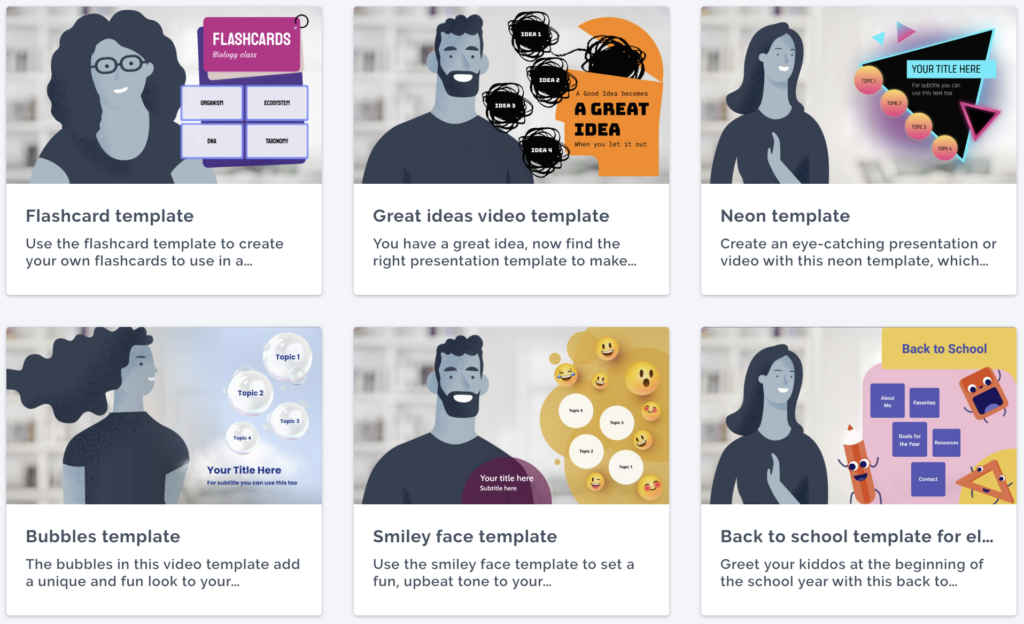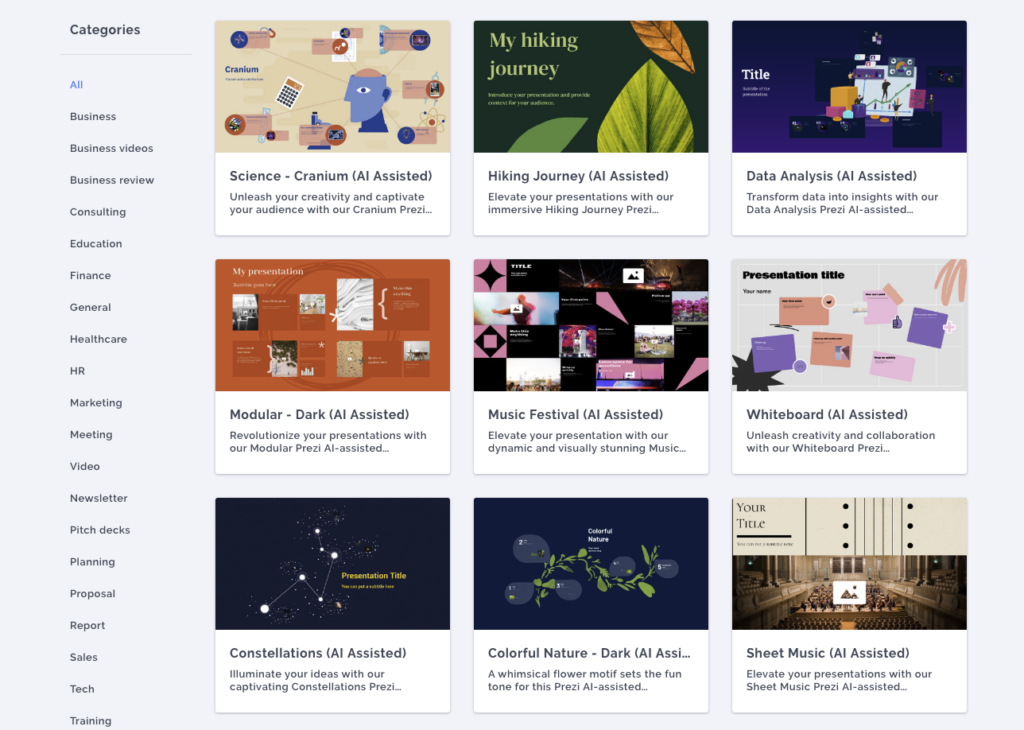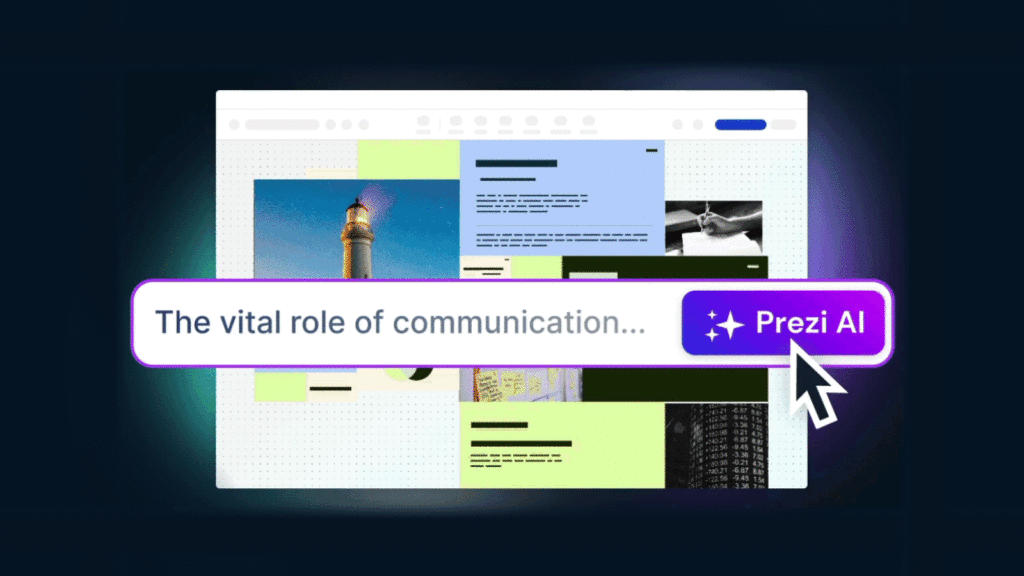Have you noticed students struggling to stay engaged during lectures? This is a common issue many classrooms face. While many factors can influence whether or not a student can hold their attention in class, some of the most common reasons include technology distractions, unclear learning objectives, and a lack of variety in teaching methods. To improve student engagement and study outcomes, let’s explore some student engagement strategies to make lectures more dynamic and effective!
Read on to learn useful student engagement strategies and discover how Prezi can improve your lessons.

The importance of student engagement strategies
When students are engaged, they participate more in class and retain information better, improving their learning. This enjoyment in learning helps them become more knowledgeable, leading to a deeper understanding of the world around them. Engaged students are curious, ask questions, and connect what they learn to real-life situations, which enriches their overall education and personal growth. As Indiana University suggests, a well-engaged student is more likely to grow into a well-rounded individual. This is why maximizing student engagement strategies is essential for any classroom.
Common errors that lead to bad student engagement
Before delving into student engagement strategies, let’s look at the factors that may lead to disengagement among students during lessons.

Lack of variety
Maintaining focus for a longer period can be difficult, especially when the presented content lacks variety. Students learn best in different ways. Including interactive activities alongside lectures caters to diverse learning styles, potentially leading to deeper understanding for everyone.
Lack of relevance
When lesson plans aren’t based on student’s interests or relate to situations that occur in real life, it’s easy for students to lose interest. They’d be more inclined to listen if they’re able to make a connection between what you teach and the things they see or experience daily in the real world.
Poor classroom management
Students may become distracted and unable to concentrate if the class is disruptive and chaotic. It’s important to make sure the learning environment is as neutral and as calm as possible for every student to reap the benefits of the lecture.
Insufficient feedback
Students need consistent feedback to understand where they’re up to with their learning. Constructive feedback allows them to have a full understanding of their progress and keeps them motivated to improve. Without it, students can be left feeling confused and this can affect their engagement in future lessons.
Neglecting student participation
Lessons with a lack of student participation create passive learners. That’s why it’s important to encourage students to speak up and ask questions to hold engagement in the classroom.
Ignoring diverse learning styles
In some classrooms, different learning styles (visual, auditory, kinesthetic) are not taken into consideration. This can make students feel alienated if they don’t align with the primary method used, leading them to lose interest.
20 student engagement strategies for maximizing understanding
Use these 20 student engagement strategies to ensure your students get the most out of every lesson:

Make lessons interactive
Introduce team projects where students solve problems together, or stage lively debates that sharpen critical thinking and communication skills. Let students learn by doing through hands-on activities that improve understanding and make the learning process more engaging.
Use technology
Technology shouldn’t be a passive distraction. Use smartboards for interactive presentations, tablets for online resources and collaborative tools, and educational apps for learning through games, making the process both fun and effective.
Real-world connections
As mentioned previously, be sure to relate learning materials to real-world scenarios relevant to student’s lives. Also, highlight how the subject connects to different careers, giving students a sense of the long-term value of their education.
Tailored teaching
Not all students learn the same way. Frequently vary your teaching approaches with different student engagement strategies to cater to the diverse learning styles and abilities present in the class.
Flipped classroom
Challenge the traditional lecture format. By providing pre-recorded lectures for homework and using class time for interactive problem-solving, you can boost engagement in the classroom.
Learn more about flipped classrooms and how to create one by watching this video:
Gamification
To keep students motivated, you could include game-like elements in your lessons. Award points for participation, create leaderboards to foster friendly competition, and even offer rewards for outstanding achievement. By turning learning into a game, you can boost motivation and keep students engaged.
Peer teaching
Learning is a two-way street. You can empower students to solidify their own understanding and develop communication skills by allowing them to teach one another. This can be done through presentations, group discussions, or even leading mini-lessons. This approach can create a collaborative learning environment where students are actively involved in their own education.

Inquiry-based learning
Encouraging students to seek their own answers is a good idea. This could involve student-led experiments, open-ended projects, or research assignments that allow them to discover knowledge on their own. By taking an active role in their learning journey, they’ll develop critical thinking, research, and problem-solving skills.
Scaffolded instruction
This is a way of building understanding progressively by breaking down complex tasks into smaller steps. Start with basic building blocks, gradually adding complexity as students master each step. Provide visuals, clear explanations, and opportunities for practice to ensure students don’t get overwhelmed.
Visual aids
Incorporate visuals like diagrams, charts, images, and even videos to improve understanding and cater to visual learners. Well-designed visuals can make abstract concepts more concrete, break down complex information, and capture students’ attention.
Active learning
Use strategies that require students to actively process and apply information. Implement strategies like “think-pair-share,” where students think about a question individually, discuss it with a partner, and then share their insights with the class. Socratic seminars can also be a powerful tool, fostering critical thinking and discussion through student-led questioning.
Classroom debates
Encourage students to research and argue opposing sides of a relevant topic connected to the lesson. This approach fosters critical thinking, research skills, persuasive communication, and the ability to see an issue from multiple perspectives.

Formative assessments
Help students stay on track by offering regular, low-stakes assessments to measure understanding and provide feedback. These can be quick quizzes, exit tickets (where students answer a question before leaving class), or informal discussions.
Learning stations
Set up different stations around the classroom with varied activities to cater to different learning preferences. Each station can offer a different activity related to the lesson, such as a hands-on experiment, a group project, a digital simulation, or an independent research task. Students can rotate through the stations at their own pace, allowing them to choose activities that best suit their learning style and interests.
Project-based learning
One way to help students deepen their understanding is by asking them to apply their learning to a real-world task. This could involve creating a campaign, building a model, or conducting research to solve a problem. By tackling projects, students can solidify understanding and develop valuable problem-solving and teamwork skills.
Learn more about project-based learning in the following video:
Real-time polling
Use clickers or online platforms to estimate student understanding or opinions during the lesson. This allows you to identify areas of confusion in real-time and adjust your teaching accordingly.
Guest speakers
Invite experts to speak on topics related to the curriculum. Guest speakers offer students a chance to hear firsthand from professionals and gain different perspectives on the subject matter. They can also answer questions, share real-world examples, and spark students’ interest in potential career paths.
Flexible seating
In order to create a comfortable and conducive learning space, you could allow students to choose their own seating arrangements. A flexible seating arrangement can promote collaboration, movement, and focus.
Student choice
Allow students to pick topics that interest them as long as they’re relevant. This gives them some control over their learning.
Prezi presentations
Use Prezi to make interactive and engaging presentations. Prezi presentations offer a dynamic and visually engaging way to capture student attention and improve learning. Prezi’s zoom function allows you to easily transition between big ideas and supporting details. Students can embed multimedia elements like images and videos, making the learning experience interactive and stimulating. With Prezi, you can transform your classroom into a visually rich and engaging learning environment that promotes deeper understanding and retention.
By implementing these student engagement strategies in your upcoming classes, you’ll foster a learning atmosphere that appeals to students and creates an environment where they feel inspired and involved.
8 student engagement strategies for remote learning
For those of you who teach remotely, here are some student engagement strategies to help your students get the most out of their learning experience:
Online interactive tools
Try using Prezi Video to create fun and interesting presentations that’ll make the lesson more dynamic and spark discussions.

Virtual breakout rooms
Breakout rooms can be used in specific online platforms such as Microsoft Teams, for small group discussions which can act as an avenue during lessons. Students can use this to reflect on what they’ve learned so far, brainstorm ideas, or work on collaborative projects.
Regular check-ins
To cater to individual needs, arrange regular personal meetings or small group meetings. This way you can provide more personalized and efficient support to every student.
Virtual field trips
Some educators like to integrate real-life experiences into the online classroom through virtual tours and online museum exhibits.
Flipped classroom with Prezi
Provide pre-recorded video lessons (such as Prezi presentations) for students to view at their own convenience, and reserve live sessions for engaging discussions and interactive activities.

Interactive whiteboards
Try using digital whiteboards like Jamboard or Miro to support teamwork and visual learning activities.
Virtual collaboration projects
Assign group projects that students can work together on using Prezi. They can collaborate in real-time to put all their findings into an engaging team presentation. By doing this, you’re encouraging them to work on their teamwork and communication, and helping to develop their digital communication skills.
How Prezi can help to keep students engaged
One of the preferred strategies for student engagement is using presentations. They give teachers the opportunity to present educational content in a way that’s more interesting than textbooks. With Prezi, you can develop presentations that deviate from the usual slide-based approach— transforming your lesson into a conversational narrative that students can gain knowledge from. Let’s consider why the use of Prezi is considered an effective student engagement strategy.
More dynamic
Prezi has a zoomable canvas feature that allows for non-linear storytelling. You can zoom in and out of important information and create a dynamic experience that visually transports your students on a learning journey. Unlike traditional slide-based presentations, Prezi can maintain student’s attention more effectively.
Visual appeal
Prezi enables you to create more engaging content by providing you with a wide range of templates and design options. With so many options available, you can find the perfect design theme for every lesson plan. Prezi’s customizable templates mean you don’t need to spend time designing every slide, which we know is a valuable resource for busy teachers. The ability to create visually appealing presentations is key for holding your student’s attention.

Interactive features
Prezi includes a variety of interactive elements like panning across the canvas and embedding multimedia. These features are effective student engagement strategies as they make presentations more interactive and dynamic.
Easy multimedia integration
With Prezi, you can embed multimedia elements directly into presentations, like videos, images, and GIFs. Including multimedia elements make presentations more exciting and your students are more likely to stay focused on the content. In contrast, plain, text-heavy slides make lessons dim, causing students to disengage.
Flexible presentation flow
The unique non-linear style of Prezi lets teachers easily adapt their presentations. If a student asks a question or needs more explanation, the teacher can quickly jump to the relevant section without disrupting the flow. This smooth navigation keeps students engaged and ensures their questions are answered promptly.
Immersive storytelling
Prezi’s zooming and panning features enable educators to craft a narrative adventure, making the learning experience feel more like storytelling through dynamic visuals rather than passive viewing of static slides. This allows students to be more engaged during lessons.
Accessibility
Prezi is cloud-based, meaning students can access the material from anywhere with an internet connection, ensuring their engagement not only during classroom sessions but also outside which can be very useful for teachers who implement the flipped classroom strategy.
Ease of use
Despite its advanced features, Prezi is simple to use. This means teachers and students alike can easily use Prezi to create and collaborate on engaging presentations no matter their technical abilities.
Prezi AI: a revolution for student engagement strategies
Prezi AI is the quickest and easiest way to create impactful presentations for students. Let’s look at the key benefits of using Prezi AI in the classroom:
- Personalized learning: It helps tailor content to fit what each student needs, making lessons more relevant and interesting.
- Efficient content creation: It makes it easier and quicker for teachers to create good-looking and organized presentations, freeing up time for more interactive teaching.
- Automated assistance: AI can help create engaging storylines for presentations, ensuring the content keeps students interested.
- Visual and multimedia integration: It can recommend visuals and multimedia elements to include in presentations, making the information easier to understand.
- Scalability: Prezi AI can help apply personalized engagement strategies to larger groups, making sure all students get the attention they need.
- Innovative learning experience: Using AI in presentations introduces students to new technology, sparking curiosity and engagement.

So, if you’re looking to improve your student engagement strategies, then take the first step by incorporating Prezi AI into your lessons.
Prezi presentation examples
We’ve put together some examples from the Prezi gallery to show you just how dynamic and engaging Prezi presentations are.
The Civil Rights Movement
This Prezi presentation on the Civil Rights Movement is a great example of incorporating student engagement strategies into presentations. It uses Prezi’s open canvas and zoom features, making the content dynamic and interactive. This keeps students interested and allows them to explore the material in a non-linear way. Additionally, the presentation includes multimedia elements like videos, which provide different ways for students to engage with and understand the content. This mix of visual storytelling and multimedia strategies to increase student engagement makes the learning experience more interactive.
Literacy Genres
This Prezi presentation on literacy genres also reflects good uses of student engagement strategies. It sticks to a literacy theme with book-related visuals, making it relatable to the subject. The modern use of vibrant colors keeps students interested. The presentation tells a story by zooming in and out on each topic, which fits the literacy theme well and makes the content more dynamic. By including a variety of strategies to promote student engagement, this presentation helps to keep students focused and makes lessons more exciting.
Understanding the teenage brain
Teachers could use this Prezi presentation for inspiration on student engagement strategies in their lessons because it effectively combines educational content with engaging multimedia elements. The presentation uses relatable images and modern colors, which are especially appealing to teenagers and help maintain their attention. The lesson includes hands-on activities, diagrams, and models related to brain functioning, making complex concepts easier to understand. The use of videos and interactive features supports diverse learning styles and keeps students actively involved in the learning process, making the material more engaging.
U.S Census – Why we do it
Teachers can find this Prezi presentation on the U.S. Census a great inspiration for student engagement strategies. It mixes interactive elements with visuals, making data interesting and relevant. The presentation’s structure, with class questions and hands-on activities, encourages participation and helps students understand the real-world importance of census data. By using this approach, teachers can create an engaging classroom environment that makes learning about statistics and data meaningful.
Make Prezi the latest addition to your student engagement strategies
Maintaining attention in class by using student engagement strategies is vital for effective learning, and Prezi can make a big difference. Using Prezi for presentations makes the classroom more interactive and fun, which helps students stay focused and interested. Its dynamic features and engaging visuals make lessons more memorable and enjoyable for everyone. By incorporating Prezi, you create a lively learning environment where students are more likely to listen and absorb the material, making teaching and learning more effective and exciting.
